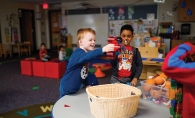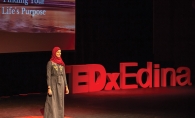Mold in the fridge can be a good thing for Liz Heinecke. This Edina mom has a M.S. in bacteriology and a keen eye for science, in and out of the kitchen. She’s created a cottage industry of making all things science more palatable to children.
In addition to blogging her way through kid-friendly home experiments at KitchenPantryScientist.com and teaching kids the tricks of her trade through community outreach programs, Heinecke is the author of Kitchen Science Lab for Kids (Quarry Books, 2014). The book is part of Quarry’s Hands-On Family series and features 52 family-friendly experiments using materials found in most households.
“Kids first learn to love science and nature in kitchens and backyards,” Heinecke says. “I wrote the book to make it fun and easy for kids of all ages to explore physics, biology and chemistry using stuff they have on hand.” Her desire to write the book was born out of her ability to “make science fun for kids and easy for parents,” she says, an ability that comes naturally to this mother of three. The idea to parlay her website into a book was a bit of a hard sell, however. Several publishing houses turned Heinecke down; it wasn’t until representatives from Quarry approached her with an idea to become part of its series that her book project came to fruition.
The book features 12 units that hit the basics of biology, chemistry, earth science and physics. Each experiment includes a materials list, safety tips, protocol, a scientific explanation of the experiment and a creative enrichment portion to encourage kids to think beyond the experiment. Projects include a microbe zoo, tie-dye milk, a pizza-box solar oven and climbing salt crystals—all using elements found in a common kitchen. “You see [ingredients] as food, but they’re chemicals,” Heinecke says of things like baking soda (sodium bicarbonate) and vinegar (acetic acid). “It’s great for kids to see science is all around them, even in their refrigerator.” Color photographs by local photographer Amber Procaccini bring the experiments to life.
“The reaction has been fantastic,” Heinecke says, noting the book once sold out after one of her national television appearances. She thinks some of that success is because the book is a bit of an antidote to modern-day habits. “Lots of people are eager to get their kids off of screens,” she says, adding that her book allows kids a platform of discovery that is free from the confines of the classroom. “It’s great for kids to engage their curiosity away from school,” she adds.
“Her excitement is contagious,” Meg Adkisson says of Heinecke. The Edina resident’s sons, Sam, 10, and Will, 9, invite neighborhood friends to participate in the book’s experiments. Sam even taught a buddy about surface tension when the friend was curious about why fish food wasn’t sinking down into his fish bowl.
If kids are committed to their screens, Heinecke has tapped into that, too. She helped develop KidScience, an Apple-friendly app. “KidScience is set up like a cooking app, full of simple recipes for experiments, photos and videos to create a science lab at your fingertips,” she says. “Kids, parents, grandparents and babysitters can use KidScience to search for fun science projects based on ingredients, kids’ ages, time available and type of science.”
Heinecke continues to explore new ways to bring science to children by updating the app, as well as with another book (due out in 2016) for Quarry’s series.









